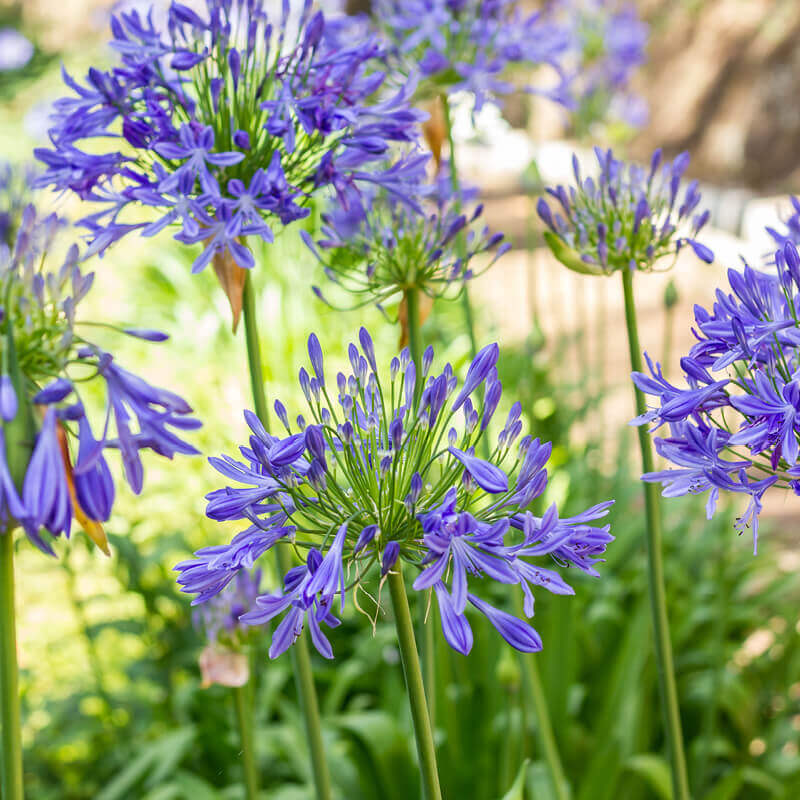Common Agapanthus Troubles and How to Address Them
Common Agapanthus Troubles and How to Address Them
Blog Article
Unleashing the Secret to Effective Agapanthus Farming: Advice for a Flourishing Garden
In the realm of gardening, cultivating agapanthus successfully requires a critical technique that encompasses different facets of plant treatment. By comprehending the subtleties of agapanthus farming, one can develop an environment where these plants thrive and grow generously.
Growing Agapanthus: Finest Practices
When planting Agapanthus, correct soil prep work is necessary for making sure successful growth and development of these gorgeous blossoms. Agapanthus, frequently referred to as Lily of the Nile or African lily, prospers in well-draining soil with a slightly acidic to neutral pH degree - Agapanthus. Before planting, it is vital to modify hefty clay dirts with raw material such as garden compost or peat moss to improve water drainage and provide vital nutrients for the plants
To plant Agapanthus, choose a place that receives full sunlight to partial shade, as this will certainly promote healthy and balanced growth and plentiful blooming. Dig an opening twice the size of the plant's origin sphere and position the Agapanthus at the exact same depth it was formerly expanding. Delicately backfill the hole with soil, pushing down strongly to remove any kind of air pockets around the roots.
Water the newly grown Agapanthus extensively and continue to maintain the dirt uniformly moist, specifically during the plant's energetic growing season. Agapanthus. Using a balanced fertilizer once a month can further support the plant's development and blooming. By following these finest techniques for growing Agapanthus, you can develop a magnificent display of these exciting flowers in your yard
Perfect Soil Conditions for Agapanthus
For optimal growth and blooming success of Agapanthus plants, making certain the dirt problems are ideal is critical. Agapanthus chooses soil that is abundant in nutrients, so integrating a balanced fertilizer throughout the expanding period can advertise healthy development and vivid flowers.

Watering and Feeding Tips
To make certain healthy and balanced growth and dynamic blooms, proper watering and feeding strategies are necessary for successful Agapanthus cultivation. Agapanthus plants take advantage of routine watering, specifically during the growing period. It is recommended to water deeply as soon as a week, making certain the dirt is damp however not waterlogged. During hot weather or in pots, more frequent watering may be needed to prevent the soil from drying out completely.
When it pertains to feeding Agapanthus, a well balanced plant food with equivalent parts nitrogen, phosphorus, and potassium can be used in the spring to advertise healthy growth and blooming. Slow-release fertilizers are ideal for offering nutrients slowly over an extensive period. Prevent over-fertilizing, as this can bring about excessive foliage development at the expenditure of blooms.
Additionally, including raw material like compost into the soil can improve nutrient degrees and boost dirt structure, assisting in the general health of the Agapanthus plants. By adhering to these watering and fertilizing suggestions, gardeners can guarantee their Agapanthus plants grow and create magnificent displays of blossoms.
Trimming and Deadheading Strategies
Correct trimming and deadheading strategies play a critical role in preserving the wellness and appearances of Agapanthus plants, complementing the important techniques of watering and fertilizing for effective growing. Pruning Agapanthus entails eliminating invested flower heads, yellowing or dead leaves, and overall shaping of the plant to promote better growth. Deadheading, the procedure of removing faded flowers, not just boosts the plant's appearance however additionally motivates further flowering.
When deadheading Agapanthus, it is suggested to snip off the flower stem at the base using sharp, tidy shears. This procedure reroutes the plant's energy from seed manufacturing back right into origin and vegetation development, advertising a much healthier and much more robust plant. Normal deadheading can expand the growing period of Agapanthus and avoid self-seeding, which can cause overcrowding.
In terms of trimming, Agapanthus normally take advantage of a light trim after flowering to clean the plant and urge fresh growth. Cutting back the invested flower stems and eliminating any dead or broken vegetation assists keep the plant's vitality check these guys out and overall appearance. However, it is necessary to stay clear of reducing into the crown of the plant, as this can weaken its health.

Protecting Agapanthus From Pests and Diseases
Executing efficient bug and condition administration techniques is essential to guarding the wellness and vigor of Agapanthus plants in cultivation. One common bug that influences Agapanthus is the Agapanthus borer, a caterpillar that passages into the plant, triggering damage to the leaves and flowers.
Along with insects, Agapanthus are susceptible to conditions such as root rot and fungal leaf areas. These concerns can frequently be avoided by making sure correct water drainage and preventing overwatering. Influenced parts of the plant must be promptly eliminated to avoid additional spread if signs of condition appear. Fungicides may likewise be used as a therapy step, adhering to the maker's directions very carefully. By remaining attentive and attending to bug and illness concerns quickly, gardeners can aid their Agapanthus grow and thrive.

Verdict
To conclude, effective farming of agapanthus calls for proper growing strategies, suitable dirt conditions, ample watering and feeding, normal trimming and deadheading, and security from bugs and conditions. By complying with these ideas and methods, garden enthusiasts can guarantee a prospering garden full of gorgeous agapanthus blooms. Agapanthus. Remember to keep consistent care and click now interest to detail to promote the health and wellness and longevity of these magnificent plants
When planting Agapanthus, appropriate soil prep work is necessary for making certain effective development and growth of these beautiful flowers.Water the freshly planted Agapanthus extensively and proceed to maintain the dirt evenly moist, particularly throughout the plant's energetic expanding season.For ideal growth and flowering success of Agapanthus plants, making certain the dirt problems are optimal is important. When hair transplanting or planting Agapanthus, ensure check out here the dirt is well-prepared to give the required foundation for the plants to establish themselves effectively. One typical parasite that influences Agapanthus is the Agapanthus borer, a caterpillar that passages into the plant, creating damage to the blossoms and leaves.
Report this page